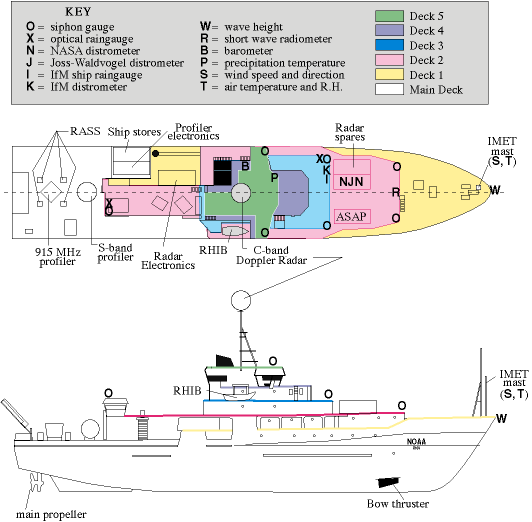
The surface meteorology instrumentation on the RONALD H. BROWN for the PACS TEPPS cruise falls into several categories:
a) Permanent sensors integrated by Woods Hole Oceanographic Institute (WHOI) into a package. Some of the instrument modules are custom built by WHOI while others are off-the-shelf instruments modified by WHOI to work on an addressable digital data bus. WHOI sensors are referred to in this documentation as "IMET" sensors. These sensors are similar to those used on the WHOI IMET buoy during TOGA COARE (Hosom et al. 1995; Weller and Anderson 1996). The PACS TEPPS cruise was the first deployment of the IMET version 2 sensors referred to by WHOI as the ASIMET (Air Sea Interaction-METeorology) suite of sensor modules. This newer version contains different models of some of the instruments compared to those used for TOGA COARE. Consequently there are some differences in performance and characteristics compared to the sensors deployed in COARE but overall the sensors are comparable. For TEPPS, the permanent IMET sensors are: wind speed and direction, air temperature and relative humidity, shortwave radiation, and one of the rain accumulation siphon gauges.
b) Permanent off-the-shelf sensors installed on the ship are the barometeric pressure sensor, 7 siphon rain gauges to measure rain accumulation, and 2 optical rain gauges.
c) Instrumentation brought on the ship specifically for the PACS TEPPS cruise were: a wave height meter, several types of distrometers, and an instrument to measure the temperature of precipitation drops (important for fluxes).
The time series data from the surface meteorology instruments are available as formatted ascii files. Descriptions of each instrument, how they were deployed on ship and characteristics of their data are provided below. Prior to distribution, the data were reformatted from the Ship Computer System (SCS) files recorded on ship and simple quality control checks were applied. The simple quality control consisted of checks for physically reasonable values to remove obviously spurious data. The bad data were set to missing in the time series.
Click on the letters marked on the ship to find out more about each instrument.
Selected Characteristics of the R/V Ronald H. Brown